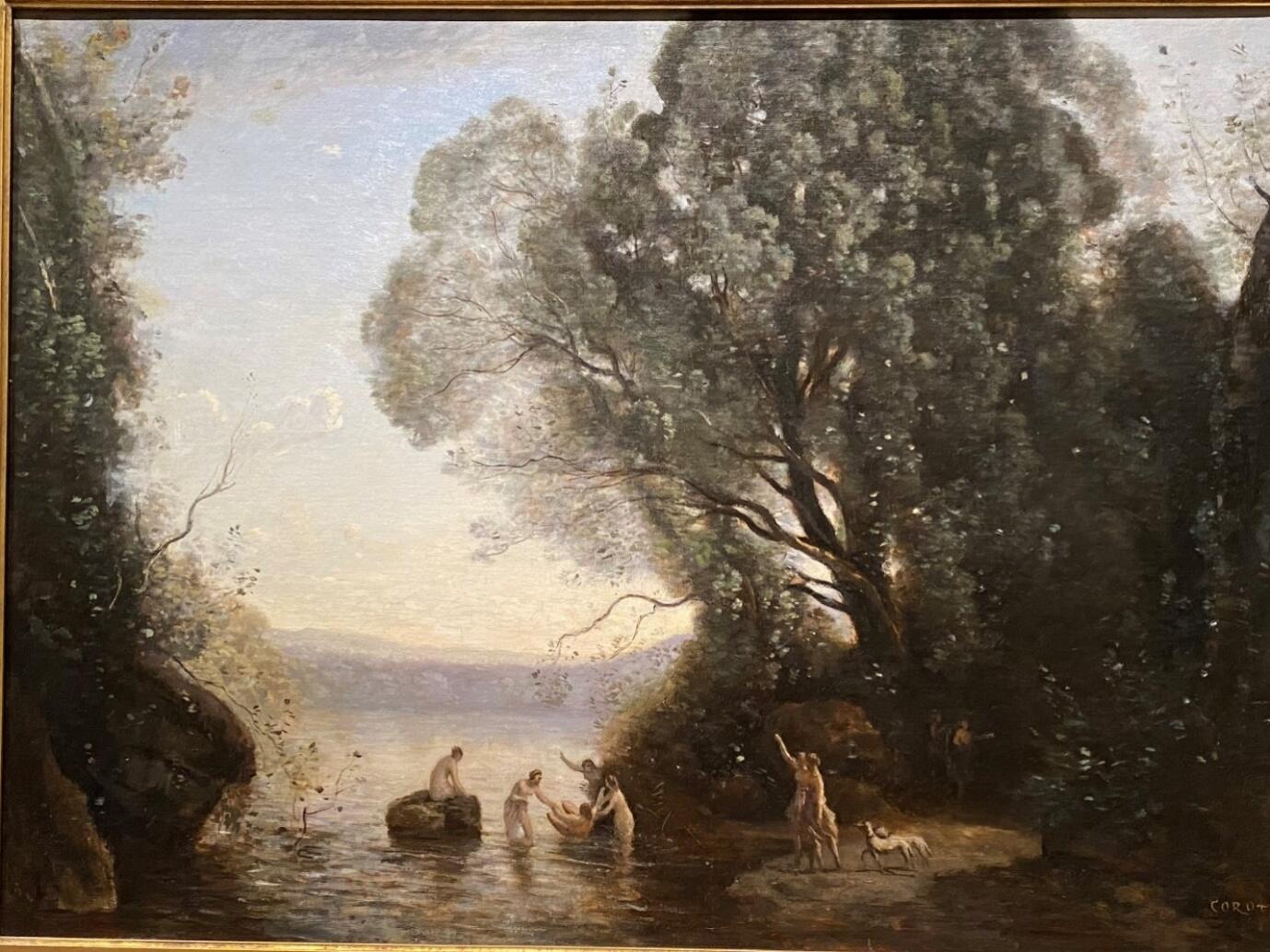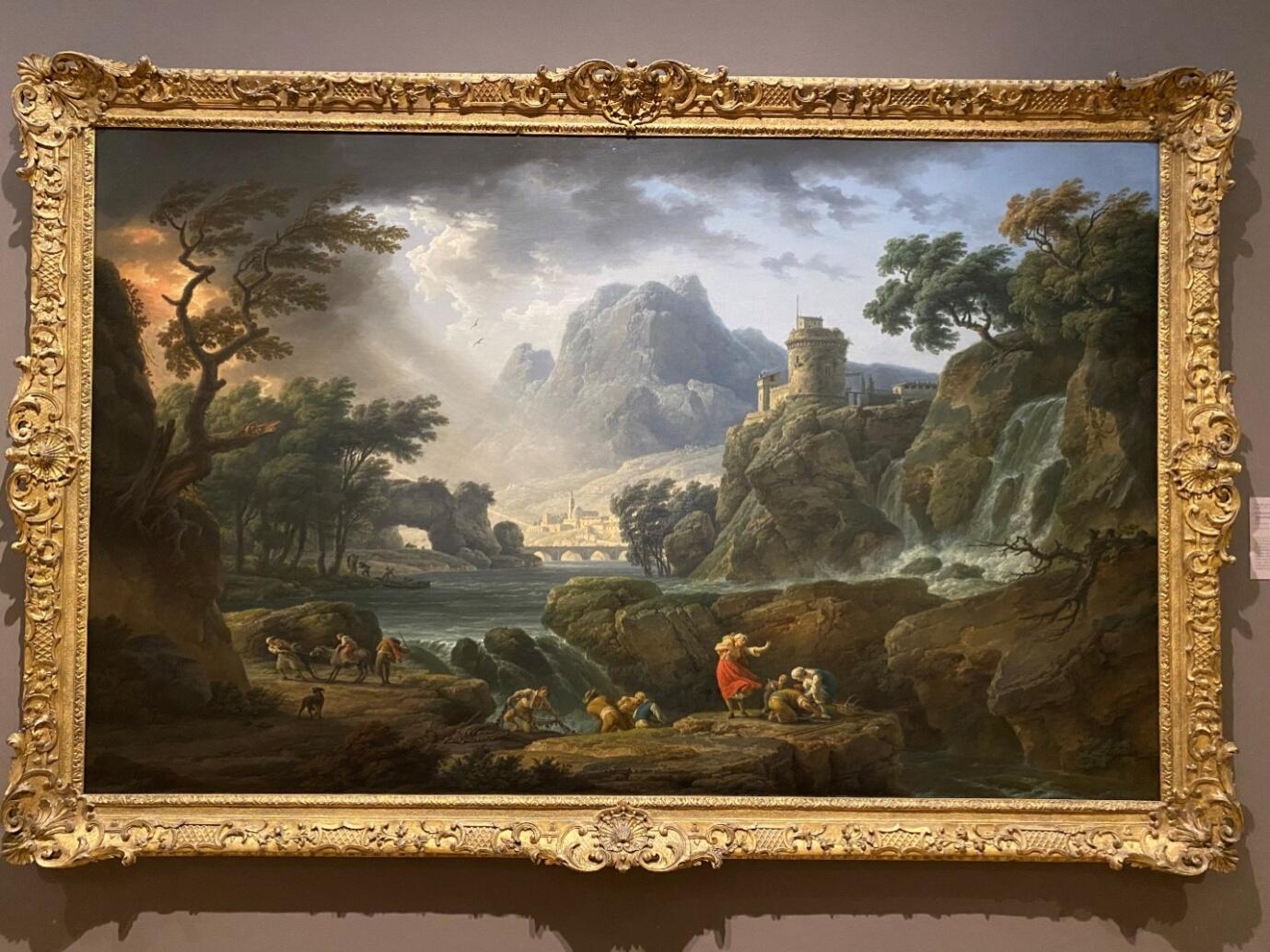Introduction
The expression of emotions and moods, as well as a call to the feelings of the viewer, are one of the essential tasks of visual art. A competent artist uses not only the plot of a picture but also drawing techniques as a medium of expression. Vivid examples of such adept application of both methods simultaneously are of the classical era is The Bath of Diana by Jean-Baptiste-Camille Corot and A Mountain Landscape with an Approaching Storm by Claude-Joseph Vernet. These works became the objects of study because they show the opposite emotions of calmness and anxiety using similar means of painting despite the difference of more than a hundred years. This work will examine from the perspective of visual and comparative analysis what methods of art prevailed in different centuries and the paradox between techniques and moods.
Main body
Jean-Baptiste-Camille Corot, the French artist of the realism movement, painted an oil picture called The Bath of Diana in 1855. The central figures of the image are Diana and other women who take part in bathing in the river. Two of them are to the left of Diana, one of which sits on a stone. Three women are on the right side of the main character of the picture, and two of them, along with two dogs, stand on the shore and keep a little closer to the viewer. Also, another woman leaves the bushes, thus being in front of Diana. The background consists of various kinds of vegetation like shrubs and trees of dark shades as well as the coastline and sky. The bright space of the picture represents the sky, which illuminates the bathing process and resonates with the hands of two women pointing up.
Of course, the focal point of the picture is a group of women located at the bottom of the image. To focus attention, the artist used not only their central location in a single place of sunlight, but also the contrast between light tones of women, water and sky, and dark tones of plants. Light tones include pastel shades of blue, gray, yellow, orange, brown, green, and flesh. Green, brown, and orange nuances make up dark tones. The conflict between the horizon and the diagonal manifested by the trees and the sky also supports the general focus. Smooth, long, and confident lines characterize images of girls, dogs, tree trunks, and branches. However, Corot applied mostly light, rough, short lines when creating the background. Dotted, somewhere inaccurate, strokes make the foliage and lighting on it. The artist avoids sharp corners and uses wavy lines and rounded shapes.
Calmness is the primary mood of The Bath of Diana. Diana is undergoing a process of sacred spiritual purification. The evidence of it is a light source directed down at her and other women, which may indicate the presence of God in this ritual. The weather transmits the feeling of some divine calm and appeasement. The viewer might observe a lack of wind when looking at the water surface, foliage, and branches. Even animals are in harmony with the environment, judging by their stance. If the paintings could convey sounds, then perhaps even the birds would remain silent in this canvas. The atmosphere of mystery and proximity, which are provided by dark, dense, almost completely covering the sky, greenery also supports the feeling of calmness. The artist created a fully immersive situation of the intimacy of the process of female bathing.
The romantic artist Claude-Joseph Vernet created an oil canvas called A Mountain Landscape with an Approaching Storm in 1775. A woman in red, and people around her, whom she may warn of an imminent thunderstorm or storm, represents the central figures. These seven people on a steep bank of the river in a hurry collect fishing rods, fishnets, and their catch. In the background, other people are also rushing to the city in a wagon, leaving the boat on the shore and driving a stubborn donkey with a cane. The background also includes the river surrounding its steep rocky bank on sides, the castle and waterfall on the right side, and the city far in the center. A massive mountain range rises above the sunlit city and the aqueduct. Darkness gradually covers the sky from left to right with thunderclouds due to the upcoming storm. Lightings of hellish colors sparkle in the upper left corner of the picture.
A woman with a child, who is the local focal point of the picture, is slight to the right of the lower center of the image, which creates visual dissonance. The red color of her clothes distracts the viewer’s attention from three people, who represent the real center; however, their dull clothes merge them with the background colors. The artist used a wide range of vibrant colors and shades such as red, orange, yellow, dark brown, dark green, deep blue, dark gray, white, and black. In general, the viewer might characterize the picture as having an extremely high degree of detail. The artist provided this effect by a multitude of heavy, smooth long thin, and sinuous lines. Another technique is a large number of heavy, sleek long, and thin lines, especially on stones, trees, and water. The environment consists of angular square shapes that contrast with the wavy and rounded silhouetted living objects. The upcoming storm as if an asteroid falls diagonally on the horizontal line of the aqueduct and the water surface.
The main motive of the work of Jean-Baptiste-Camille Corot is anxiety. First of all, the artist provided this feeling by the dissonance of points of attention on the canvas. In the foreground, a woman in red is not in the center; the lighting falls on her and her surroundings as well as on a group of people with a donkey. In the background, the castle tower, the city, the top of the mountain, and lightning simultaneously attract the viewer’s eye. The town in the distance may be the general center of the picture, but the bright red color of the dress always distracts the focus. Nature announces the impending threat with the dog, donkey, strong winds, and frightened birds. The contrasting infernal unnatural color palette of lightning and thunderclouds possibly portray God’s anger, and the light yellow city is the only haven in the picture. The location of people on a steep bank even causes a feeling of fear of falling into a raging river.
The presence and influence of God in the most intimate aspects of human life is a common motive for both paintings. This similarity lies in the correlation between light colors and security. The sun completely illuminates the bathing process, as well as the city under the mountain, which will soon be under the shadow of a divine thunderstorm. The presence of Biblical motifs and divine principles in paintings were standard, if not mandatory, practice for most artists until the beginning of the 20th century. Also, in each of the two pictures, there is a body of water represented as a river, and even if they have a radically different mood, nevertheless they both fulfill an emotional function. Canvases have a common element of the plot during which people complete activities in rivers after seeing changes in the sky. Both artists actively used weather and nature in their paintings to express the spirits. The movement of the clouds occurs from left to right in both works, and the dogs turned their heads to the upper left corner.
The viewer might trace the common technique of focusing attention through the intersection of horizontal and diagonal in these two works. Also, Corot and Vernet captured participants of both paintings at the moment of their greatest attention to weather changes. Similar shades of green, brown, and blue make up the picture of both surroundings. The viewer sees the far background of both canvases, mainly on the left side of the paintings. Also, both artists emphasize the attention in both artworks at the bottom of the picture. The works of Corot and Vernet have a common paradox between the applied techniques and transmitted moods. Nervous short and rough strokes suggest an alarming sense of work, while long, accurate, and thin lines should convey calm.
One of the most critical semantic differences is the value of the diagonal line from the upper left corner to the center of the picture. In the case of The Bath of Diana, it means divine favor and support, but in A Mountain Landscape with an Approaching Storm, it symbolizes the Wrath of God. Artists clearly expressed these emotions by the colors which represent the light source and clouds, light blue tones of The Bath of Diana against the dark gray shades of A Mountain Landscape. The plot of the sky is also different; it is absolutely calm in the work of the 19th century, while in the canvas of the 18th century, aggressively moving clouds will soon completely cover the sky. Corot portrayed a distant background only in the form of small wooded hills, and Vernet’s canvas has a vast mountain range and urban area. Also, there are entirely no buildings in The Bath of Diana; nature constitutes everything in the picture. The patterns of the flow of the rivers differ by dividing into a raging, turbulent stream and small calm ripples.
Conclusion
The scale of the paintings is also different; the work of Jean-Baptiste-Camille Corot captured events much smaller than the canvas of Claude-Joseph Vernet. The nature of the colors corresponds to the moods of calmness and anxiety; the first painting uses pastel shades, while bright colors completely filled the second canvas. The leisurely pastime of Diana and the women contrasts with the anxiety of the inhabitants of the mountain landscape. The colors depicting people in The Bath of Diana are in perfect harmony with the environment and almost merge with it. In A Mountain Landscape, the purpose of tones and shades is to highlight and contrast the participants with their surroundings. Also, people are located on the right strand in the first painting and on the left in the second. Corot’s canvas represents the ideal of sealed calmness, and Vernet’s artwork is a perfect sample of visually depicted anxiety. For a clear understanding of the principal differences between the two works, it is enough to look at the branches on the right of A Mountain Landscape and in the center of the Bathing of Diana.

